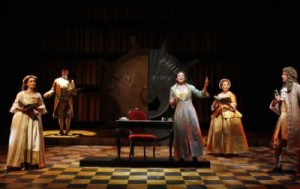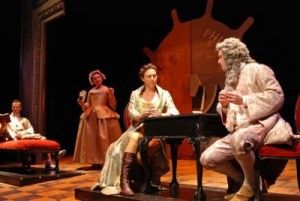RECOMMENDED
When South Coast Repertory announced the world premiere of Emilie—La Marquise Du Châtelet Defends Her Life At The Petit Théâtre At Cirey Tonight, I had two thoughts. The first was, “What a long title for a play!” and the second was, “Who the heck is Emilie?” Doubtless for those with an inability to remember long titles, SCR’s webside has redubbed Lauren Gunderson’s play a short but sweet Emelie. As for Emilie du Châtelet, a quick Wikipedia search reveals the following: Gabrielle Émilie Le Tonnelier de Breteuil, marquise du Châtelet (December 17, 1706 – September 10, 1749) was a French mathematician, physicist, and author during the Age of Enlightenment.
If a mathematician-physicist didn’t initially strike me as all that interesting a lead character for a play, a womanscientist born over three centuries ago did appear to have the potential to appeal to contemporary audiences.
The finished product, currently on the Julianne Argyros stage at South Coast Rep, would seem to prove me right on both points.
When Emilie is sparring with Voltaire about her theory of “Force Vive” (I never did quite get what that meant), Emilie The Play tends to be distancing to those of a not particularly scientific or philosophical bent. On the other hand, some bright performances, the script’s cleverer aspects, and a smashing design do perk things up, particularly in the second act.
Emilie (Natacha Roi) narrates her life from the grave. We first meet her as she discovers that she has somehow returned to life, or at least to a kind of life. “Breath. Body. Again. Space. And Time. Again? Life again?” muses Emilie at lights up. She then moves on to discuss “things called living and things called dead that exist as people” and “things called ‘living’ and things called ‘dead’ that exist as numbers and the squaring of numbers.” She writes F=mv² on a board behind her and continues. “Force Vive, it’s called The Living Force.” Remove the squared sign and it’s dead, put the little ² back and it’s alive again.
Did you get that?
I didn’t, and perhaps that’s why although I appreciated the playwright’s ambitions, I found the subject matter to be often a bit too dry and esoteric for my tastes.
On the other hand, some clever conceits make Emilie The Play a highly theatrical experience, and of interest simply for that.
You see, since Emilie is technically still dead, and though she is able to converse and interact with the people who surrounded her during her life, whenever she attempts to touch them, it’s like metal in a microwave. Vincent Olivieri’s very clever sound design and Lonnie Rafael Alcaraz’s equally striking lighting combine to “electrocute” Emilie and the object of her tactile impulses, at least until she pulls back from the person she’s touching. Thus, whenever physical contact is required, Emilie enlists the help of her “makeout double,” Rebecca Mozo, who steps in to perform and body-to-body, lip-to-lip action.
Voltaire (Don Reilly) does, at first at least, seem taken by Emilie’s intellect as well as her beauty, but when her theory of “Force Vive” puts her in the public spotlight, he appears threatened by her fame as his male ego begins to rear its ugly head. (Have things changed all that much in the past three hundred years?) On the other hand, Emilie’s younger lover (Matthew Humphreys, portraying all the play’s younger gentlemen) seems quite content to play Ashton to her Demi.
The bulk of the acting responsibilities fall on the shoulders of the two leads. Roi combines intelligence, femininity, and a strong stage presence, but a considerable number of fluffed lines in the first act suggest that more time is needed for her to fully take charge of the role. Reilly is the more confident of the two, capturing Voltaire’s male ego and his defensiveness whenever his masculinity was called into question. Mozo and Humphreys are very good (and appear to be having great fun) with their multiple supporting roles, as is Susan Denaker playing all older female parts.
Director David Emmes does his best to perk up the drier sections of Gunderson’s script, and there are numerous bright moments, particularly in the second act.
Cameron Anderson’s fanciful set design, full of gears (or are they suns radiating rays?) fits the script nicely, but it is Nephelie Andronyadis’ costume design which dazzles with its silks, bustles, and plunging necklines (featuring ample décolletage). Wigs, both women’s and men’s, are first rate as well.
I’d guess that those of a more intellectual bent will find Emilie more engrossing than I did, but it is certainly cleverly staged and gorgeously designed.
South Coast Repertory, 655 Town Center Drive, Costa Mesa.
www.scr.org
–Steven Stanley
April 26, 2009
Photos: Henry DiRocco




 Since 2007, Steven Stanley's StageSceneLA.com has spotlighted the best in Southern California theater via reviews, interviews, and its annual StageSceneLA Scenies.
Since 2007, Steven Stanley's StageSceneLA.com has spotlighted the best in Southern California theater via reviews, interviews, and its annual StageSceneLA Scenies.







 COPYRIGHT 2024 STEVEN STANLEY :: DESIGN BY
COPYRIGHT 2024 STEVEN STANLEY :: DESIGN BY